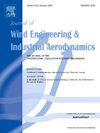全风向下可调倾角太阳能光伏系统面板的概率特性和风压极值研究
IF 4.2
2区 工程技术
Q1 ENGINEERING, CIVIL
Journal of Wind Engineering and Industrial Aerodynamics
Pub Date : 2024-10-12
DOI:10.1016/j.jweia.2024.105913
引用次数: 0
摘要
本研究针对非高斯特性对光伏结构板风压峰值系数和极值的影响进行了一项新颖的调查,解决了当前设计方法中的一个关键缺陷。对可调倾角太阳能光伏系统的刚性模型进行了风洞试验,提供了重要的面板风压数据。通过对风压时间历史、概率密度、偏度、峰度和统计分布的综合分析,这项研究确定了明显的非高斯特征,并突出了面板上的敏感区域。研究采用了三种极值估计方法来计算峰值风压,并比较了它们的准确性。结果表明,GPD 方法提供了最精确的极值风压计算,优于传统的基于高斯的方法,后者通常会将峰值风压低估 30%-50%。此外,将全风向数据与单风向极值进行比较后发现,设计值可能会被高估,这表明使用单风向极值可能会将极端风压的正值夸大 1.1-1.25 倍,负值夸大 1.1-1.15 倍。这项研究强调了在光伏系统结构设计中纳入非高斯特征和全风向考虑的必要性,以避免低估或过度设计,尤其是在敏感地区。这些发现为提高可再生能源应用中结构设计的精确性和安全性提供了宝贵的见解。本文章由计算机程序翻译,如有差异,请以英文原文为准。
Research on probabilistic characteristics and wind pressure extreme values of adjustable-tilt solar photovoltaic systems panels under full-direction wind
This study presents a novel investigation into the impact of non-Gaussian characteristics on wind pressure peak factors and extreme values in photovoltaic structural panels, addressing a critical gap in current design methodologies. A wind tunnel test was conducted on a rigid model of an adjustable-tilt solar photovoltaic system, providing essential panel wind pressure data. Through a comprehensive analysis of wind pressure time history, probability density, skewness, kurtosis, and statistical distributions, this research identified distinct non-Gaussian characteristics and highlighted sensitive areas on the panel. The study utilized three extreme value estimation methods to calculate peak wind pressures and compared their accuracy. Results demonstrate that the GPD method offers the most precise calculations of extreme wind pressure, outperforming traditional Gaussian-based approaches, which often underestimate peak pressures by 30%–50%. Additionally, the comparison of full-direction wind data with single wind direction extremes reveals potential overestimations in design values, suggesting that using one-directional extremes could inflate extreme wind pressure by 1.1–1.25 times for positive and 1.1 to 1.15 times for negative values. This study underscores the necessity of incorporating non-Gaussian features and full-direction wind considerations in the structural design of photovoltaic systems to avoid underestimation or over-design, particularly in sensitive regions. These findings contribute valuable insights for enhancing the precision and safety of structural design in renewable energy applications.
求助全文
通过发布文献求助,成功后即可免费获取论文全文。
去求助
来源期刊
CiteScore
8.90
自引率
22.90%
发文量
306
审稿时长
4.4 months
期刊介绍:
The objective of the journal is to provide a means for the publication and interchange of information, on an international basis, on all those aspects of wind engineering that are included in the activities of the International Association for Wind Engineering http://www.iawe.org/. These are: social and economic impact of wind effects; wind characteristics and structure, local wind environments, wind loads and structural response, diffusion, pollutant dispersion and matter transport, wind effects on building heat loss and ventilation, wind effects on transport systems, aerodynamic aspects of wind energy generation, and codification of wind effects.
Papers on these subjects describing full-scale measurements, wind-tunnel simulation studies, computational or theoretical methods are published, as well as papers dealing with the development of techniques and apparatus for wind engineering experiments.

 求助内容:
求助内容: 应助结果提醒方式:
应助结果提醒方式:


